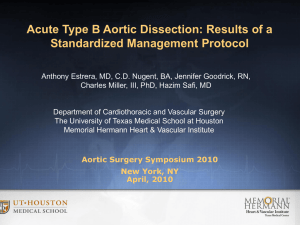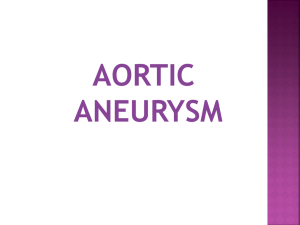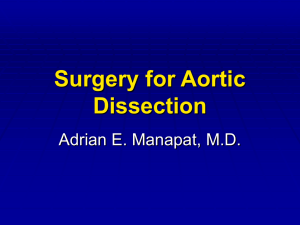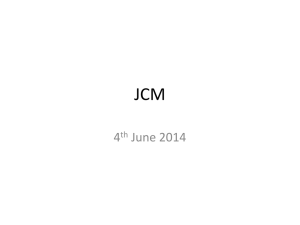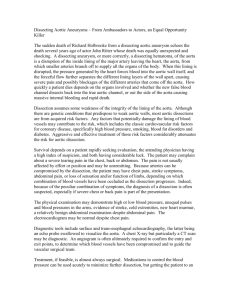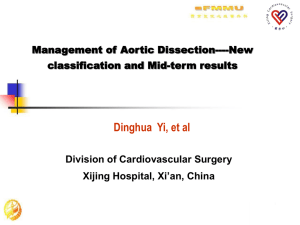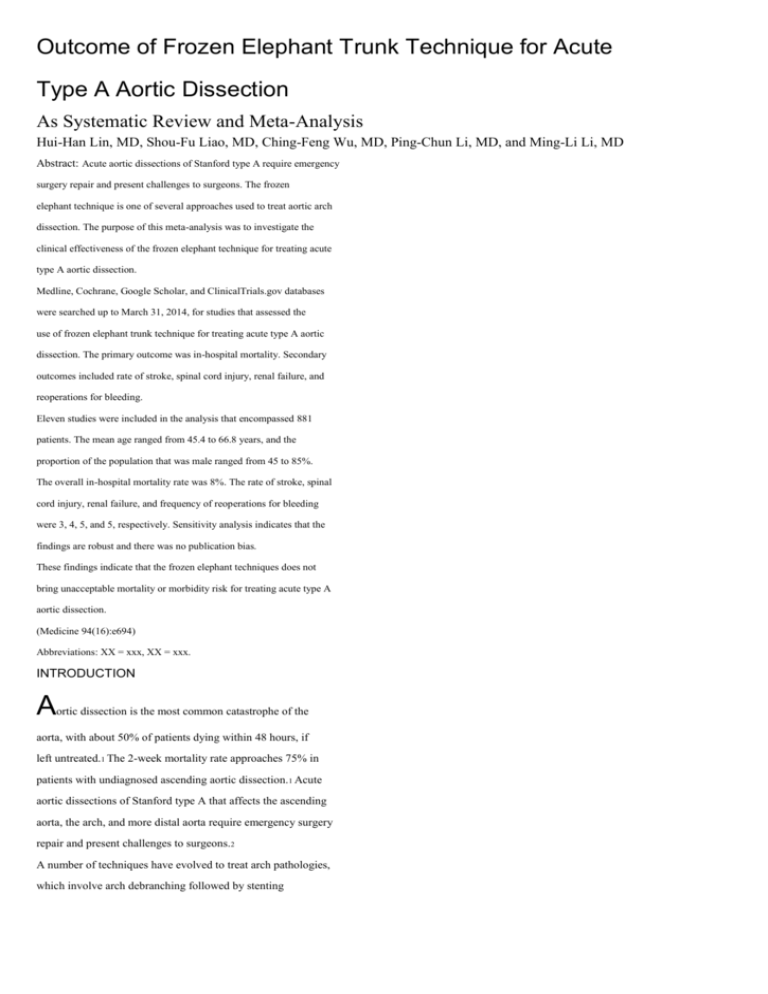
Outcome of Frozen Elephant Trunk Technique for Acute
Type A Aortic Dissection
As Systematic Review and Meta-Analysis
Hui-Han Lin, MD, Shou-Fu Liao, MD, Ching-Feng Wu, MD, Ping-Chun Li, MD, and Ming-Li Li, MD
Abstract: Acute aortic dissections of Stanford type A require emergency
surgery repair and present challenges to surgeons. The frozen
elephant technique is one of several approaches used to treat aortic arch
dissection. The purpose of this meta-analysis was to investigate the
clinical effectiveness of the frozen elephant technique for treating acute
type A aortic dissection.
Medline, Cochrane, Google Scholar, and ClinicalTrials.gov databases
were searched up to March 31, 2014, for studies that assessed the
use of frozen elephant trunk technique for treating acute type A aortic
dissection. The primary outcome was in-hospital mortality. Secondary
outcomes included rate of stroke, spinal cord injury, renal failure, and
reoperations for bleeding.
Eleven studies were included in the analysis that encompassed 881
patients. The mean age ranged from 45.4 to 66.8 years, and the
proportion of the population that was male ranged from 45 to 85%.
The overall in-hospital mortality rate was 8%. The rate of stroke, spinal
cord injury, renal failure, and frequency of reoperations for bleeding
were 3, 4, 5, and 5, respectively. Sensitivity analysis indicates that the
findings are robust and there was no publication bias.
These findings indicate that the frozen elephant techniques does not
bring unacceptable mortality or morbidity risk for treating acute type A
aortic dissection.
(Medicine 94(16):e694)
Abbreviations: XX = xxx, XX = xxx.
INTRODUCTION
A
ortic dissection is the most common catastrophe of the
aorta, with about 50% of patients dying within 48 hours, if
left untreated.1 The 2-week mortality rate approaches 75% in
patients with undiagnosed ascending aortic dissection.1 Acute
aortic dissections of Stanford type A that affects the ascending
aorta, the arch, and more distal aorta require emergency surgery
repair and present challenges to surgeons.2
A number of techniques have evolved to treat arch pathologies,
which involve arch debranching followed by stenting
over the aortic arch. The frozen elephant technique is one hybrid
approach that was adapted from the classic elephant trunk
technique first described by Borst et al.3–5 The elephant trunk
technique involves 2 steps. In the first step, the ascending aorta
and arch are repaired by a median sternotomy, and in the second
step, a free-floating extension of the arch prosthesis (ie, the
elephant trunk) is left behind in the proximal descending
aorto.3–5 In the frozen elephant technique, the endovascular
component is performed either simultaneously or in stages. A
‘‘hybrid’’ vascular graft made up of a conventional tube graft
with an endovascular stented graft at the distal end is used to
achieve a blood-tight seal in the descending aorta.6–8 This
allows for the treatment of the aortic arch and proximal descending
pathologies in a single operation, which helps to
minimize complications and reduce high mortality associated
with the classical elephant technique.6–8
Prior meta-analyses have assessed the efficacy and safety
of different hybrid techniques including the frozen elephant
technique in treating aortic arch dissection.9–11 However, they
either included type B aortic dissection or other aortic diseases.
Our meta-analysis investigated the clinical effectiveness of the
frozen elephant technique for specifically treating acute type A
aortic dissection.
METHODS
Study Search
Meta-analyses do not involve humans and do not require
Institutional Review Board review. The systematic review and
meta-analysis was performed in accordance with the PRISMA
guidelines.12 Medline, Cochrane, Google Scholar, and ClinicalTrials.
gov databases were searched up to March 31, 2014, for
studies that assessed the use of frozen elephant technique for
treating acute type A aortic dissection. The search terms
included frozen elephant trunk, stent grafting technique, hybrid
technique, and aortic dissection. All identified studies were
reviewed by 2 independent reviewers, and where there was a
discrepancy, a third reviewer was consulted. Studies were
included if patients were _18 years of age, had been diagnosed
with acute Stanford type A aortic dissection, or acute DeBakey
type I or type II aortic dissection. Included studies involved the
hybrid technique that combined open arch surgery and aortic
endovascular treatment (ie, frozen elephant trunk method).
Studies were excluded if they did not report separate outcomes
for patients with acute type A aortic dissection, or include only
patients with chronic aortic dissections or with thoracic aortic
aneurysms. Non-English or non-Chinese publications, letters,
comments, editorials, and case reports were also excluded.
Editor: Bernhard Schaller.
Received: November 3, 2014; revised: March 2, 2015; accepted: March 3,
2015.
From the Division of Cardiovascular Surgery (HHL, CFW, PCL, MLL),
China Medical University Hospital, Taichung; and Department of Surgery
(SFL), National Taiwan University Hospital, Taipei, Taiwan.
Correspondence: Hui-Han Lin, Division of Cardiovascular Surgery, China
Medical University Hospital, 2 Yuh-Der Road, Taichung 40447,
Taiwan (e-mail: Lhh0203@ms42.hinet.net).
The authors have no funding and conflicts of interest to disclose.
Copyright # 2015 Wolters Kluwer Health, Inc. All rights reserved.
This is an open access article distributed under the Creative Commons
Attribution-NonCommercial-NoDerivatives License 4.0, where it is
permissible to download, share and reproduce the work in any medium,
provided it is properly cited. The work cannot be changed in any way or
used commercially.
ISSN: 0025-7974
DOI: 10.1097/MD.0000000000000694
Medicine _ Volume 94, Number 16, April 2015 www.md-journal.com | 1
Data Extraction
Data was extracted by 2 independent reviewers, and if
necessary, a third was consulted to resolve disagreements. The
following information was extracted from studies that met the
inclusion criteria: the name of the first author, year of publication,
study design, patient demographics, diagnosis, type of
intervention, length of follow-up, and postoperative outcomes.
Quality Assessment
The modified 18-item Delphi checklist was used to assess
the quality of the included studies, which is designed for
assessing the quality of single-arm clinical study.13 Similar
to study selection and data extraction, 2 independent reviewers
performed the quality assessment and a third reviewer was
consulted to resolve any disagreements.
Statistical Analysis
The primary outcome was in-hospital mortality. Secondary
outcomes included rate of stroke, spinal cord injury, renal
failure, and reoperations for bleeding.
Event rates with 95% confidence intervals (CIs) were
calculated for binary outcomes for each individual study and
for those studies combined. A x2-based test of homogeneity was
performed and the inconsistency index (I2) and Q statistics were
determined. If I2 was >50% or >75%, the trials were considered
to be heterogeneous or highly heterogeneous, respectively.
If I2 was <25%, the studies were considered to be
homogeneous. If the I2 statistic were >50%, a random-effects
model (DerSimonian–Laird method) was used. Otherwise,
fixed-effects models (Mantel–Haenszel method) were
employed. Combined effects were calculated and a 2-sided P
value <0.05 was considered to indicate statistical significance.
Sensitivity analysis was carried out for the primary outcome
using the leave-one-out approach. Publication bias was assessed
by constructing funnel plots for primary outcome by Egger test.
The absence of publication bias was indicated by the data points
forming a symmetric funnel-shaped distribution and 1-tailed
significance level P>0.05 (Egger test). All analyses were
performed using Comprehensive Meta-Analysis statistical software,
version 2.0 (Biostat, Englewood, NJ).
RESULTS
The initial search identified 224 studies, 196 of which were
excluded, following screening of the titles and abstracts,
because of not being relevant for the analysis (Figure 1).
Twenty-eight studies were reviewed in depth and 17 were
excluded for not investigating acute type A aortic dissection
(n¼5) and not reporting findings for type A aortic dissection
FIGURE 1. Flowchart of study selection.
Lin et al Medicine _ Volume 94, Number 16, April 2015
2 | www.md-journal.com Copyright # 2015 Wolters Kluwer Health, Inc. All rights reserved.
TABLE 1. Summary of Study and Operative Characteristics on Aortic Arch Surgeries Utilizing the Frozen Elephant Trunk
Technique
Paper
No.
First Author
(Year)
Study
Design
Type of
Patients Prosthesis
Circulatory Arrest
Temperature, 8C_
Number of
Patients
Age,
y
Male
(%)
Follow-Up,
mo_
1 Xiao (2014)23 Prospective Acute Stanford type A
aortic dissection
Stent graft (Shanghai MicroPort
Medical Co, Ltd, Shanghai,
China)
18.9 (2.7) 33 48.0 73% 27.2 (15.3)
2 Hoffman (2013)15 Retrospective Acute Stanford type A
aortic dissection
E-Vita open plus hybrid prosthesis
(Jotec, Hechingen, Germany)
20 (core) 32 58 81% 17 (4)
3 Ma (2013)22 Retrospective Acute Stanford type A
aortic dissection
4-branched vascular graft 25 398 46 82% NA
4 Roselli (2013)14 Prospective DeBakey type I acute aortic
dissections
Dacron graft with GoreTAG stent
(Gore Medical, Flagstaff, AZ,
USA)
18 17 61.4 82% NA
5 Tamura (2014)17 Retrospective Acute Stanford type A
aortic dissection
Gianturco Z-stents (Cook Inc,
Bloomington, IN, USA)
28 25 64 64% Median 58
(range 12–169)
6 Shen (2012)21 Prospective Acute Stanford type A
aortic dissection
4-branch graft with self-expanding
stent
22 (rectal) 38 45.4 74% 12 (3)
7 Shi (2011)20 Retrospective Stanford type A aortic dis
section
Self-expandable stent vessel
prosthesis
23.7 (3.7) (rectal) 46 52.7 76% 13.7 (7.4)
8 Sun (2011)3 Retrospective Stanford Type A acute aor
ticdissection
4-branch prosthetic graft with stent
graft
18-22 148 45 85% 42 (18)
9 Uchida (2011)16 Retrospective DeBakey type I acute aortic
dissection
UBE graft (UBE Industries Ltd.,
Tokyo, Japan)
28 (rectal) 80 66.8 45% 74.3 (48.0)
10 Chen (2010)19 Retrospective Debakey I aortic dissection Woven Dacron graft with Gian
turco-type self-expandable
metallic stent (Microport
Medical Corp., Shanghai, China)
22–25 (rectal) 28 51.2 79% 30.1 (19.3)
11 Pochettino
(2009)18
Prospective Acute Stanford type A
aortic dissection
Dacron graft (Vascutec Ltd,
Renfrewshire, Scotland) with
GoreTAG stent (W. L. Gore &
Associates, Flagstaff, AZ, USA)
NA 36 59 NA 15.9
_
Data presented in mean (standard deviation).
Medicine _ Volume 94, Number 16, April 2015 Elephant Trunk and Aortic Dissection
Copyright # 2015 Wolters Kluwer Health, Inc. All rights reserved. www.md-journal.com | 3
(n¼11), and were duplicate studies (n¼1). Eleven studies
were included in the systematic review and meta-analysis
(Table 1).3,14–23
Study Characteristics
Of the 11 studies included in the final analysis, all were
observational in design, and 3 were prospective and 8 were
retrospective studies. A total of 881 patients were encompassed
by all 11 studies (range 25–398 patients) (Table 1). The mean
age ranged from 45.4 to 66.8 years, and the proportion of the
population that was male ranged from 45% to 85%. Follow-up
ranged from about 13 to 74 months. A variety of prostheses
were utilized across the studies.
In-Hospital Mortality
All of the included studies in the meta-analysis reported the
in-hospital mortality after utilizing the frozen elephant trunk
technique (Table 2). Ten studies14–18,19–21,23 reported in-hospital
mortality, whereas only one22 reported early mortality.
x2-based test of homogeneity indicated that there was heterogeneity
among the 11 studies (Q statistic¼17.42, I2¼45.58%,
P¼0.066); hence, a fixed-effects analysis was used. The overall
in-hospital mortality was 8% (95% CI¼0.06 to 0.10,
P<0.001, Figure 2A).
Stoke Rate
All 11 studies reported the events of stroke following
surgery (Table 2). x2-based test of homogeneity indicated that
there was no heterogeneity among the 11 studies (Q
statistic¼10.44, I2¼4.24%, P¼0.408); consequently, a
fixed-effects analysis was used. The overall stroke rate was
3% (95% CI¼0.02 to 0.05, P<0.001, Figure 2B).
Rate of Spinal Cord Injury
Nine of the studies3,14–18,20–22 reported the frequency of
spinal cord injury after surgery (Table 2). A fixed-effects
analysis was used because of the homogeneity among the
studies (Q statistic¼6.86, I2¼0%, P¼0.552). The overall rate
of spinal cord injury was 4% (95% CI¼0.03 to 0.06, P<0.001,
Figure 2C).
Rate of Renal Failure
Eight of the 11 studies3,14,16–19,22,23 reported postsurgery
events of renal failure (Table 2). A random-effects analysis
was used because of the heterogeneity among the studies
(Q statistic¼21.25, I2¼67.06%, P¼0.003). The overall rate
of renal failure was 5% (95% CI¼0.02 to 0.10, P<0.001,
Figure 2D).
Rate of Reoperations for Bleeding
Seven studies3,15–17,19–21 reported the events of reoperations
to treat bleeding (Table 2). Analysis of the pooled data
indicated that there was homogeneity among the studies
(Q statistic¼5.48, I2¼0%, P¼0.484); therefore, a fixedeffects
analysis was used. The overall rate of reoperation for
bleeding was 5% (95% CI¼0.03 to 0.08, P<0.001, Figure 2E).
Sensitivity Analysis and Publication Bias
Sensitivity analysis was performed using the leave-one-out
approach for in-hospital mortality with each study removed in
turn (Figure 3). The direction and magnitude of combined
TABLE 2. Operative Durations and Clinical Outcomes for Studies Utilizing the Frozen Elephant Trunk Technique
Paper
No.
First
Author
(Year)
Cardiopulmonary
Bypass
Time, min
Cross-Clamp
Time, min
Circulatory
Arrest
Time, min
Cerebral
Perfusion
Time, min
In-Hospital
Mortality
(%)
Stroke
(%)
Spinal
Cord Injury
(%)
Renal
Failure
(%)
Reoperation
for Bleeding
(%)
1 Xiao (2014)23 296.9 (54.3) 174.2 (39.3) 52.2 (33.2) NA 6 (18%) 0 NA 1 (3%) NA
2 Hoffman (2013)15 219 (39.2) 152 (38.7) 57 (6.7) 43 (4) 0 0 0 NA 4 (13%)
3 Ma (2013)22 201 (51) 111 (31) NA 24 (8) 31 (9%)_ 10 (3%) 17 (4%) 10 (3%) NA
4 Roselli (2013)14 NA NA 28 (4) NA 0 2 (12%) 0 1 (6%) NA
5 Tamura (2014)17 163_ NA 34_ 69_ 0 1 (4) 0 3 (12%) 1 (4)
6 Shen (2012)21 159 (60.1) 116.3 (39.9) 38 (16.9) 40.1 (21.2) 3 (8%) 0 2 (5%) NA 0
7 Shi (2011)20 107.9 (17.7) 79.7 (15.8) 35.5 (7.1) 35.5 (7.1) 1 (2%) 0 0 NA 2 (4%)
8 Sun (2011)3 197 (47) 107 (27) NA 24 (9) 7 (5%) 4 (3%) 3 (2%) 1 (1%) 5 (3%)
9 Uchida (2011)16 178 (48) NA NA 78 (18) 2 (3%) 2 (3%) 0 3 (4%) 4 (5%)
10 Chen (2010)19 213.2 (47.2) 141.9 (32.5) 27.2 (6.8) 38.8 (9.7) 4 (14%) 3 (11%) NA 2 (7%) 1 (4%)
11 Pochettino (2009)18 245 (39) NA 60 (13) NA 5 (14%) 1 (3%) 3 (8%) 6 (17%) NA
_
Early mortality.
Lin et al Medicine _ Volume 94, Number 16, April 2015
4 | www.md-journal.com Copyright # 2015 Wolters Kluwer Health, Inc. All rights reserved.
FIGURE 2. Meta-analysis for (A) in-hospital mortality, (B) stroke, (C) spinal cord injury, (D) renal failure, and (E) reoperation for
bleeding.
Medicine _ Volume 94, Number 16, April 2015 Elephant Trunk and Aortic Dissection
Copyright # 2015 Wolters Kluwer Health, Inc. All rights reserved. www.md-journal.com | 5
estimates did not vary markedly with the removal of the studies,
indicating that the meta-analysis had good reliability and the
data was not overly influenced by each study. The results via
Egger test showed that there was no publication bias for the
findings with regard to in-hospital mortality (t¼1.139, 1-tailed,
P¼0.142, Figure 4).
Quality Assessment
The modified 18-item Delphi checklist was used to assess
the quality of the included studies (Table 3). In general, the
quality across the reported studies was high. However, the lack
of reporting of several important experimental characteristics
may have affected overall quality of several of the included
studies. All of the studies were single-site studies.
Six3,14,15,18,20,21 of the 11 studies did not report if the patients
were recruited consecutively. Four did not report the length of
follow-up postsurgery,3,14,18,22 and none reported the percentage
of patients who were lost to follow-up. Two studies19,21 did
not report adverse events.
DISCUSSION
Our meta-analysis investigated the efficacy and safety of
the frozen elephant technique when applied for the treatment of
acute type A aortic dissection. We found that, overall, the inhospital
rate was 8%, and the rate of stroke, spinal cord injury,
renal failure, and frequency of reoperations resulting from
bleeding was _5%. Sensitivity and publication bias analyses
indicated that the findings are robust; none of the study overly
influenced the findings and there was no publication bias.
Overall, the included studies were of high quality. These
findings indicate that the frozen elephant techniques does not
bring unacceptable mortality or morbidity risk for treating acute
type A aortic dissection.
Our findings are consistent with several prior metaanalyses
that assessed the safety and efficacy of hybrid aortic
arch replacement for treating aortic arch pathologies. Cao et al10
performed a systematic review of periprocedural mortality and
neurologic outcomes of hybrid procedures to treat aortic arch
dissection and other aortic diseases. The pooled data came from
50 studies that included 1886 patients. Perioperative mortality
across all hybrid techniques and aortic pathologies had a pooled
event ratio of about 11%, and perioperative stroke and spinal
cord ischemia had pooled ratios of 6.9% and 6.8%, respectively.
For dissected aorta, the pooled rate was 9.8% for mortality rate,
4.3% for stroke, and 5.8% for spinal cord ischemia. The authors
conclude that hybrid repair carries minimal risk of perioperative
mortality and neurologic morbidity.
Moulakakis et al11 performed a systematic review and
meta-analysis that evaluated the efficacy of hybrid techniques in
patients with aortic arch pathologies. They included 46 studies
in the analysis that consist of 2272 patients. Of the included
studies, 26 studies (n¼956 patients) reported aortic debranching
procedures and 20 studies (n¼1316 patients) performed
either stented or frozen elephant trunk technique. The pooled
estimate for the 30-day/in-hospital stay mortality for elephant
trunk technique was 9.5% and for the arch debranching was
9.5%. Irreversible spinal cord injury symptoms were 5.0% and
3.6%, respectively. Cerebrovascular events were low, 6.2% for
elephant trunk technique and 7.6% for arch debranching.
Similar to Cao et al,10 the authors conclude that hybrid repair,
including elephant trunk technique, provides a safe alternative
to open repair. Although the authors do note that stroke and
mortality rates are still a concern.
Only 1 prior meta-analysis by Tian et al9 focused on the
safety and efficacy of the frozen elephant trunk technique.
However, in contrast to our study, they assessed the use of this
technique to treat multiple aortic pathologies. Their analysis
included 17 observational studies. The pooled mortality was
FIGURE 3. Sensitivity analysis for in-hospital mortality.
FIGURE 4. Funnel plot for publication bias for in-hospital
mortality.
Lin et al Medicine _ Volume 94, Number 16, April 2015
6 | www.md-journal.com Copyright # 2015 Wolters Kluwer Health, Inc. All rights reserved.
TABLE 3. Summary of Quality Assessment
First Author (Year)
Xiao
(2014)23
Hoffman
(2013)15
Ma
(2013)22
Roselli
(2013)14
Tamura
(2014)17
Shen
(2012)21
Shi
(2011)20
Sun
(2011)3
Uchida
(2011)16
Chen
(2010)19
Pochettino
(2009)18
1 Is the hypothesis/aim/objective of the
study clearly stated in the abstract,
introduction, or methods section?
YYYYYYYYYYY
2 Are the characteristics of the partici
pants included in the study
described?
YYYYYYYYYYY
3 Were the cases collected in >1 center? N N N N N N N N N N N
4 Are the eligibility criteria (inclusion
and exclusion criteria) to entry the
study explicit and appropriate?
YYYYYYYYYYY
5 Were participants recruited consecu
tively?
YNYNYNNNYYN
6 Did participants enter the study at a
similar point in the disease?
YYYYYYYYYYY
7 Was the intervention clearly described
in the study?
YYYYYYYYYYY
8 Were additional interventions (cointerventions)
clearly reported in the
study?
NNNNNNNNNNN
9 Are the outcome measures clearly
defined in the introduction or
methods section?
YYYYYYYYYYY
10 Were relevant outcomes appropriately
measured with objective and/or subjective
methods?
YYYYYYYYYYY
11 Were outcomes measured before and
after intervention?
NNNNNNNNNNN
12 Were the statistical tests used to assess
the relevant outcomes appropriate?
YYYYYYYYYYY
13 Was the length of follow-up reported? Y Y N N Y Y Y N Y Y N
14 Was the loss to follow-up reported? N N N N N N N N N N N
15 Does the study provide estimates of the
random variability in the data
analysis of relevant outcomes?
NNNNNNNNNNN
16 Are adverse events reported? Y Y Y Y Y N Y Y Y N Y
17 Are the conclusions of the study sup
ported by results?
YYYYYYYYYYY
18 Are both competing interest and source
of support for the study reported?
YYYYYYYYYYY
N¼No, Y¼Yes.
Medicine _ Volume 94, Number 16, April 2015 Elephant Trunk and Aortic Dissection
Copyright # 2015 Wolters Kluwer Health, Inc. All rights reserved. www.md-journal.com | 7
8.3%, stroke was 4.9%, and spinal cord injuries were 5.1%. Five
of the studies reported the 5-year survival to be between 63%
and 88%. They found a strong linear correlation of length of
time for cardiopulmonary bypass, myocardial ischemia, and
circulatory arrest with perioperative mortality.
The elephant trunk technique requires 2 stages of the
operation. Across different studies that evaluated the use of
this technique, each stage of the operation is associated with a
certain degree of mortality: first-stage mortality rate ranged
from 0% to 32.1%, and second stage ranged from 0% to
33.3%.24 The mortality at each stage indicates a limitation of
the staged approach.24 The frozen elephant technique involves a
1-stage repair. Several studies indicate that the mortality associated
with the single-stage frozen elephant trunk technique
ranges from 0% to 12.8%.24 In 2 studies that compared conventional
and frozen elephant trunk technique, the rate of inhospital
deaths was similar between the techniques; the mean
in-hospital mortalities for elephant trunk technique were
21.6%25 and 13.9%,26 and for frozen elephant trunk technique
were 8.7%25 and 4.8%26 (P_0.100). In one of the studies,25 but
not the other, the frozen elephant trunk technique was associated
with new-onset paraplegia (P<0.001). In both the studies,
permanent neurologic dysfunction was similar between treatments
(P>0.05). These findings support the finding that the
frozen elephant technique is associated with an acceptable
mortality rate.
There are several limitations to our analysis that should be
considered when interpreting the results. The number of comparative
studies included in our analysis was too small to
perform a comparison of the frozen elephant technique with
other techniques to treat type A aortic arch dissection. Most of
the included studies were retrospective in design and differences
in surgical parameters and patient baseline characteristics
may partially explain the heterogeneity seen across the studies
and possibly affect our results. There was little information in
the included studies regarding long-term survival, indicating the
need for well-designed long-term studies to investigate
this question.
In conclusion, our analysis found that frozen elephant
trunk technique for aortic arch dissection did not result in
unacceptable rates of mortality and morbidity risks. Although
this analysis did not compare elephant trunk technique to
another method(s), it still gives insight into the use of this
technique and highlights the need for prospective studies that
compare different open conventional or other hybrid techniques
with the frozen elephant technique.
REFERENCES
1. Wiesenfarth JM. Acute Aortic Dissection. http://emedicine.medscape.
com/article/756835-overview. Accessed October 6, 2014.
2. Hiratzka LF, Bakris GL, Beckman JA, et al. 2010 ACCF/AHA/
AATS/ACR/ASA/SCA/SCAI/SIR/STS/SVM Guidelines for the diagnosis
and management of patients with thoracic aortic disease. A
Report of the American College of Cardiology Foundation/American
Heart Association Task Force on Practice Guidelines, American
Association for Thoracic Surgery, American College of Radiology,
American Stroke Association, Society of Cardiovascular Anesthesiologists,
Society for Cardiovascular Angiography and Interventions,
Society of Interventional Radiology, Society of Thoracic Surgeons,
and Society for Vascular Medicine. J Am Coll Cardiol.
2010;55:e27–e129.
3. Sun L, Qi R, Zhu J, et al. Total arch replacement combined with
stented elephant trunk implantation: a new ‘‘standard’’ therapy for
type a dissection involving repair of the aortic arch? Circulation.
2011;123:971–978.
4. Jakob H, Tsagakis K, Pacini D, et al. The International E-vita Open
Registry: data sets of 274 patients. J Cardiovasc Surg. 2011;52:717–
723.
5. Borst HG, Walterbusch G, Schaps D. Extensive aortic replacement
using ‘‘elephant trunk’’ prosthesis. Thorac Cardiovasc Surg.
1983;31:37–40.
6. Heinemann MK, Buehner B, Jurmann MJ, et al. Use of the
‘‘elephant trunk technique’’ in aortic surgery. Ann Thorac Surg.
1995;60:2–6.
7. Estrera AL, Miller CC 3rd, Porat EE, et al. Staged repair of
extensive aortic aneurysms. Ann Thorac Surg. 2002;74:S1803–
S1805.
8. Kato M, Ohnishi K, Kaneko M, et al. New graft-implanting method
for thoracic aortic aneurysm or dissection with a stented graft.
Circulation. 1996;94 (suppl 9):II188–II193.
9. Tian DH, Wan B, Di Eusanio M, et al. A systematic review and
meta-analysis on the safety and efficacy of the frozen elephant trunk
technique in aortic arch surgery. Ann Cardiothorac Surg.
2013;2:581–591.
10. Cao P, De Rango P, Czerny M, et al. Systematic review of clinical
outcomes in hybrid procedures for aortic arch dissections and other
arch diseases. J Thorac Cardiovasc Surg. 2012;144:1286–1300.
11. Moulakakis KG, Mylonas SN, Markatis F, et al. A systematic review
and meta-analysis of hybrid aortic arch replacement. Ann Cardiothorac
Surg. 2013;2:247–260.
12. Liberati A, Altman DG, Tetzlaff J, et al. The PRISMA statement for
reporting systematic reviews and meta-analyses of studies that
evaluate health care interventions: explanation and elaboration. Ann
Intern Med. 2009;151:W65–W94.
13. Moga C, Guo B, Schopflocher D, et al. Development of a quality
appraisal tool for case series studies using a modified Delphi
technique. Edmonton, Alberta, Canada: Institute of Health Economics;
2012.
14. Roselli EE, Rafael A, Soltesz EG, et al. Simplified frozen elephant
trunk repair for acute DeBakey type I dissection. J Thorac
Cardiovasc Surg. 2013;145 (suppl 3):S197–S201.
15. Hoffman A, Damberg AL, Schalte G, et al. Thoracic stent graft
sizing for frozen elephant trunk repair in acute type A dissection. J
Thorac Cardiovasc Surg. 2013;145:964–969.
16. Uchida N, Katayama A, Tamura K, et al. Frozen elephant trunk
technique and partial remodeling for acute type A aortic dissection.
Eur J Cardiothorac Surg. 2011;40:1066–1071.
17. Tamura K, Uchida N, Katayama A, et al. The frozen elephant trunk
technique for retrograde acute type A aortic dissection. J Thorac
Cardiovasc Surg. 2014;148:561–565.
18. Pochettino A, Brinkman WT, Moeller P, et al. Antegrade thoracic
stent grafting during repair of acute DeBakey I dissection prevents
development of thoracoabdominal aortic aneurysms. Ann Thorac
Surg. 2009;88:482–489.
19. Chen X, Huang F, Xu M, et al. The stented elephant trunk procedure
combined total arch replacement for Debakey I aortic dissection:
operative result and follow-up. Interact Cardiovasc Thorac Surg.
2010;11:594–598.
20. Shi E, Gu T, Yu L, et al. Repair of Stanford type A aortic dissection
with ascending aorta and hemiarch replacement combined with
stent-graft elephant trunk technique by using innominate cannulation.
J Thorac Cardiovasc Surg. 2011;142:1458–1463.
21. Shen K, Tang H, Jing R, et al. Application of triple-branched stent
graft for Stanford type A aortic dissection: potential risks. Eur J
Cardiothorac Surg. 2012;41:e12–e17.
Lin et al Medicine _ Volume 94, Number 16, April 2015
8 | www.md-journal.com Copyright # 2015 Wolters Kluwer Health, Inc. All rights reserved.
22. Ma WG, Zhu JM, Zheng J, et al. Sun’s procedure for complex aortic
arch repair: total arch replacement using a tetrafurcate graft with
stented elephant trunk implantation. Ann cardiothorac Surg.
2013;2:642–648.
23. Xiao Z, Meng W, Zhu D, et al. Treatment strategies for left
subclavian artery during total arch replacement combined with
stented elephant trunk implantation. J Thorac Cardiovasc Surg.
2014;147:639–643.
24. Karck M, Kamiya H. Progress of the treatment for extended aortic
aneurysms: is the frozen elephant trunk technique the next standard
in the treatment of complex aortic disease including the arch? Eur J
Cardiothorac Surg. 2008;33:1007–1013.
25. Leontyev S, Borger MA, Etz CD, et al. Experience with the
conventional and frozen elephant trunk techniques: a single-centre
study. Eur J Cardiothorac Surg. 2013;44:1076–1082.
26. Di Eusanio M, Borger M, Petridis FD, et al. Conventional versus
frozen elephant trunk surgery for extensive disease of the thoracic
aorta. J Cardiovasc Med (Hagerstown). 2014;15:803–809.
Medicine _ Volume 94, Number 16, April 2015 Elephant Trunk and Aortic Dissection
Copyright # 2015 Wolters Kluwer Health, Inc. All rights reserved. www.md-journal.com | 9

